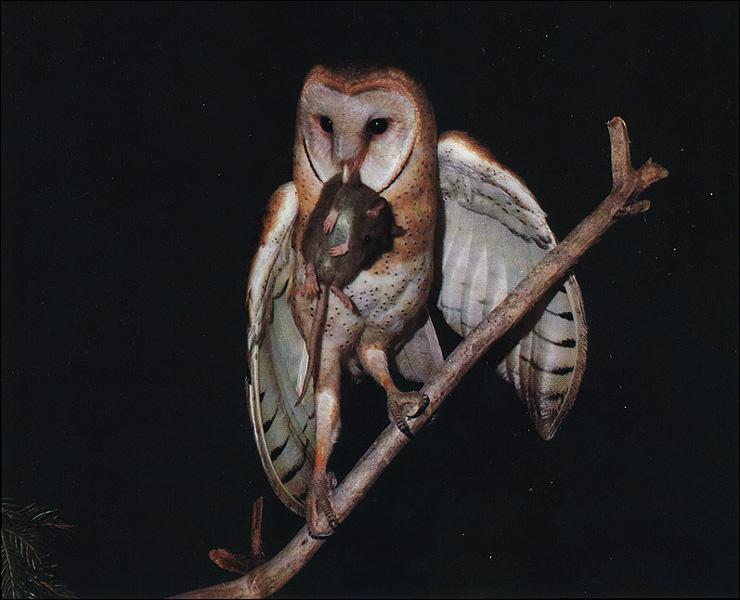

In the morning they walked outside to the barn - for Mrs. He and his wife went to bed, satisfied their troubles were over. He stomped on the owl and kicked it toward the acequia a few times and finally picked it up and threw it across the irrigation ditch. As it did, he raised the gun and shot the remaining round. He blasted the tree - Blam! Blam! Blam! Blam! Blam! - and then stepped out to walk toward the tree. He went out the gate and stood against the wall, trying to figure out which cottonwood it was in, and after a few minutes it screamed again. He heard it fly out of the alamo in the courtyard but then heard it in another alamo along the nearby acequia. Again Cesario went outside with the shotgun, but this time he stayed against the wall as he searched. The very next night the owl again awakened them. She bandaged him up and they went back to bed. As she knelt by him, she could hear the maniacal laughter of the owl fading in the distance as it flew away. He fell to the ground yelling which brought his wife out to see what was the matter.

He took a few steps to gain another vantage point, and as he did, the owl swooped out of the darkness and struck him on the head, ripping his scalp open. As he stood in the courtyard he peered up into the alamo (cottonwood) where the sound had come from - but he could not see it. This made him mad, so he grabbed his shotgun (which held six rounds) and went outside. An hour later, however, it was back, and again he chased it away. Cesario opened a window and leaned out and hollered at the bird, which flew away. She yelled at it and it flew away.Ī few days later, Cesario and his wife were awakened by the screams of a barn owl perched in a tree in the courtyard of their adobe house. An owl arrived after moonrise and lit on the doorstep and began bowing repeatedly. She decided to wait in the courtyard the next night and see who was coming each night. This disturbed her, for her mother had told her that brujas (witches) put a curse on people in this way. The next morning a headless dead chicken was on the doorstep. That puzzled her, but she merely swept them away. Torres found ashes spread on the doorstep. After becoming aware of her bad influence, Cesario's wife took her aside and suggested that a better attitude would help every one. She began gossiping with the other wives and telling lies about the Torres family. She was always complaining about too much work, or that people did their jobs wrong. One of his men had a very disagreeable wife. He also dug 14 miles of acequias along the Pecos River upstream from Camp Melvin (just north of Iraan.) Over the years he brought more than 70 families to the region from his birth town of Uvalde. Cesario Torres arrived in Fort Stockton in 1867 and formed an irrigation company, digging miles of acequias (irrigation ditches) from Comanche Spring to areas of fertile soil.

We adapted the tale so we could also tell about an important settler in Fort Stockton. The "la lechuza story" is told in every country where Spanish is spoken. For many cultures the hooting of an owl is a forewarning of a death in the family. Apache Indians, for example, will postpone a planned activity if an owl is heard. Owls are considered "wise old birds" in some cultures, while other cultures fear owls. La lechuza is the barn owl, the pale (almost white) owl. Another story that we tell is the legend of la lechuza. On the Web site search engine, type in Comanche Burrowing Owl Tale to read that story. One of those stories is on the Sibley Web site. The female will eat the heads of the prey and tear the rest apart to feed the young, so the young will not choke on the thicker bones of the skull.ĭuring another part of the program we tell folktales about owls. Researchers believe the reason for this is that the males might eat the young. Only the female great horned and barn owls physically feed their young although the male also catches prey for the young. The bigger owls often have favorite "eating perches" where they bring their prey of mice and rats. Often several dozen burrowing owls live in one prairie dog town, so they have to disperse over a greater area to locate their prey of grasshoppers, beetles and a few birds. Our resident barn and great horned owls have smaller ranges than our burrowing owls.


 0 kommentar(er)
0 kommentar(er)
